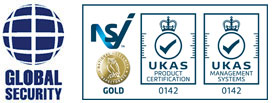There are a variety of access control systems available to ensure security in your business premises. However, choosing which is most appropriate can feel like a challenge, so we’ve broken down four of the most popular options to help you find the best access control system for your needs.
Digital keypad
A digital keypad is one of the most common and simple access control systems. Usually they require a numerical code to gain access to a property or a room. The advantage is that you can share the code with whoever needs it, making these kinds of systems ideal where a large number of people need to gain access.
For instance, digital keypads work well on blocks of flats or in the lobbies of business premises, where many people come and go. The downside to these systems is that once someone knows the code, they can share it with others without your knowledge.
The other downside is that if you decide you should update the code, you will need to notify all the people who need access.
Card swipe or scan entry systems
These are the next step up from digital keypads in many ways. You have greater control over who has access to a building or area of a building if this is restricted to physical card holders.
As you are generally unlimited in the number of cards you can issue for such systems, they are useful for buildings with high numbers of workers or residents. There are also systems that will record whose card is used to swipe in and when, helping you keep track of sensitive access areas.
Of course, cards can be lost or even stolen, but with this kind of system you can easily deactivate the relevant card once it’s reported missing.
Biometric fingerprint systems
Biometric fingerprint systems take security to the next level. We all know that our fingerprints are unique, which means rather than handing over an access card that has the potential to be shared or lost, you can grant individuals access based on their fingerprints.
This is much more secure and allows you to control who can access which buildings or areas much more tightly.
There are weatherproof and durable fingerprint access control systems suitable for external use on buildings, as well as scanners that are designed for internal areas.
Biometric face readers
Similar to biometric fingerprint scanners, biometric face readers also allow you tightly control access by limiting it to specific individuals. The main advantage of using a face reader over a fingerprint scanner is the touchless nature of such systems.
Some models of face scanners also feature built-in temperature detection to add an extra layer of security. In recent years, facial recognition technology has come a long way. Many of us are used to using it to unlock our devices like our phones or laptops, so using it to access buildings is another logical step.
Biometric face readers can also be used in conjunction with other access control methods, such as a fingerprint scanner or even a card reader, to ensure multi-factor authentication for particularly sensitive areas of a building.
When you’re considering which access control system you should implement, consider what level of security you are seeking first and foremost. The likes of biometric fingerprint or face readers are ideal where you only want to grant access to specific individuals.
However, for buildings or rooms that many people need access to, card readers or digital keypads might be more appropriate and provide sufficient security for your premises.

Leave A Comment